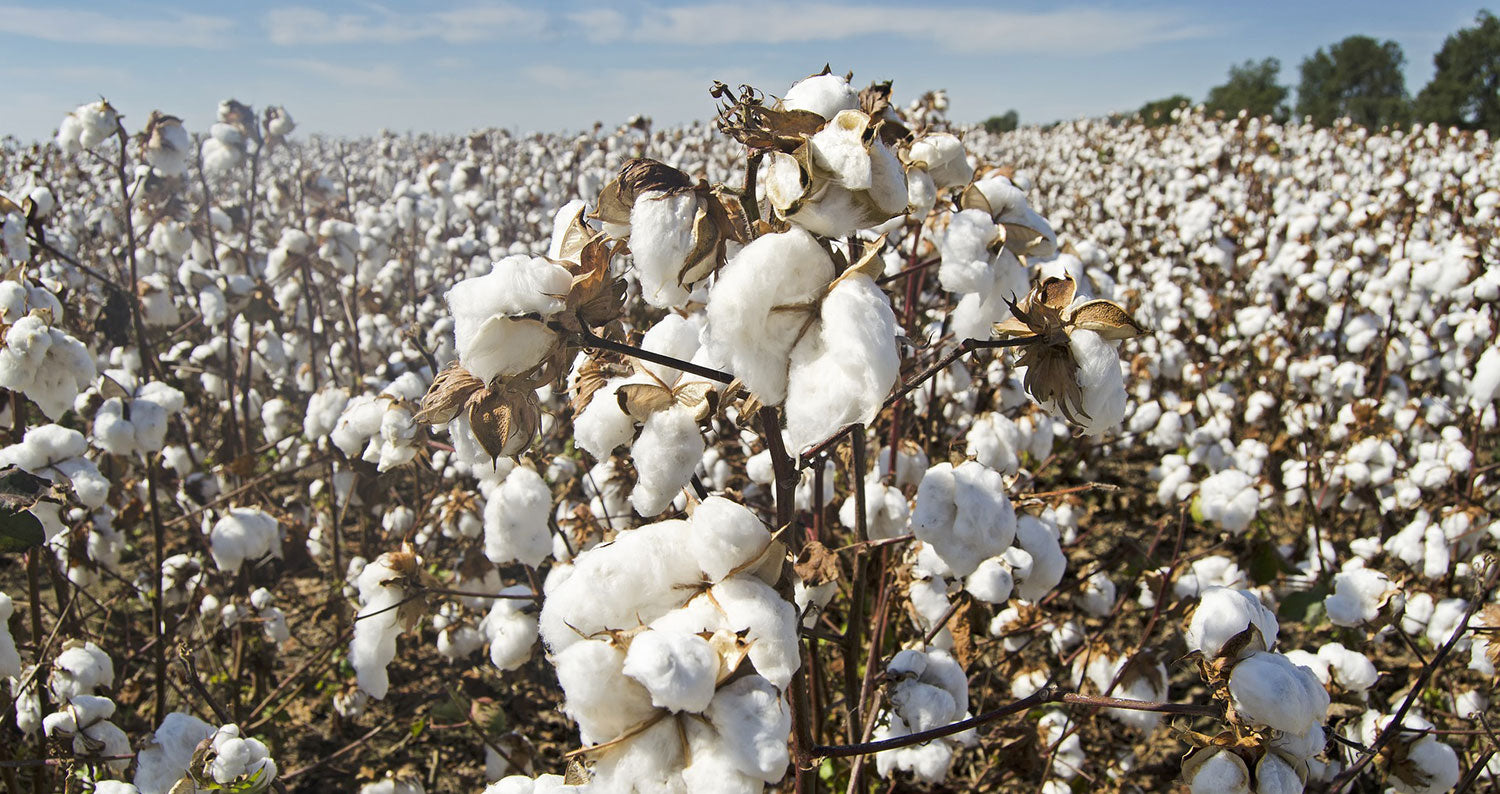Have you ever heard of regenerative cotton? Think of it as a new way of growing cotton that's all about working with nature, not against it. This blog post is your go-to guide for understanding what regenerative cotton is all about. You'll find out how it's shaking up the traditional farming scene and the benefits it brings to the table for everyone involved.
Quick Links
-
Summary of regenerative cotton
-
What is cotton?
-
What is regenerative agriculture?
-
What is regenerative cotton?
-
The difference between regenerative & organic cotton
-
Regenerative or organic cotton?
-
Why do we need regenerative cotton?
-
The future of regenerative cotton
Summary of regenerative cotton
- Regenerative cotton is a type of cotton grown using principles and practices of regenerative agriculture, which aims to improve soil health, increase biodiversity, and create a closed-loop system.
- The benefits of regenerative cotton include improved soil health, increased water retention, reduced dependence on synthetic chemicals/pesticides as well as promoting biodiversity.
- Regenerative cotton farming has environmental (reduced soil degradation), economic (reduce reliance on external inputs) and social benefits for local communities by creating jobs & reducing poverty.
- Its use is becoming increasingly popular among farmers & textile producers due to the increasing demand from consumers for sustainable products; this trend is expected to continue in the future.
- agood company promotes sustainable products made from regenerative cotton with the aim of contributing towards a more sustainable future for all.
What is cotton?
Cotton is one of the most widely used natural fibres in the world. It is used to make clothing, textiles, and household goods. While cotton is a versatile and valuable crop, its production can have a significant impact on the environment. Traditional cotton farming can lead to soil degradation, water scarcity, and the use of harmful chemicals. This is why the concept of regenerative cotton is becoming increasingly important.

What is regenerative agriculture?
Regenerative agriculture is a way of farming that focuses on nurturing and restoring the health of the land and the ecosystems it supports. It's like giving nature a helping hand to do its best work. It's a farming approach that works with nature to heal the land. Farmers use special techniques to boost soil health, like planting diverse crops and using fewer chemicals. Now, let's explore what regenerative cotton is, why it is needed, and its future potential.
What is regenerative cotton?
Regenerative cotton is a type of cotton that is grown using regenerative agriculture practices. Regenerative cotton is a special kind of cotton grown in a way that takes extra good care of the environment and the soil. This type of farming, called regenerative agriculture, focuses on making the land healthier, the water cleaner, and the whole ecosystem happier.
The difference between organic cotton and regenerative cotton is that organic cotton is only concerned with avoiding the use of synthetic chemicals and pesticides, while regenerative cotton goes beyond that to focus on improving soil health, increasing biodiversity, and promoting a closed-loop system.
The good things about regenerative cotton are that it makes the soil stronger, helps it hold onto water better, and reduces the need for synthetic chemicals and pesticides. Regenerative cotton farming also promotes biodiversity, which can help to improve the health of local ecosystems and reduce the impact of pests and diseases.

In regenerative cotton farming, certain core principles and practices stand out, such as using cover crops to build soil health, rotating crops to reduce pest pressure, and using compost and other natural inputs to improve soil fertility. Regenerative cotton farmers also often use agroforestry, which involves planting trees in and around crops to provide shade, promote biodiversity, and make the soil even better.
What is the difference between regenerative cotton and organic cotton?
Regenerative cotton is a more comprehensive approach to sustainable farming than organic cotton. Whereas organic cotton focuses on eliminating the use of synthetic pesticides, fertilizers, and other harmful chemicals, regenerative cotton goes further by focusing on restoring soil health, improving biodiversity, and reducing environmental impact. Regenerative farmers also often use cover crops and intercropping to help improve soil fertility, reduce water waste, and increase carbon sequestration. By contrast, organic cotton is primarily focused on eliminating synthetic chemicals from the farming process.
The main difference between regenerative cotton and organic cotton is that regenerative farmers often use additional practices to maintain healthy soils and reduce environmental impact while organic farmers may not. Regenerative cotton may have higher environmental and social benefits than organic cotton, while both are better for the environment compared to conventional practices. Both regenerative and organic cotton are more expensive than conventional cotton due to their commitment to sustainability and responsible farming. However, with increased consumer awareness of the importance of sustainable farming practices, there is a growing demand for sustainable fibres, such as regenerative cotton.
Which is better, regenerative cotton or organic cotton?
The answer depends on the specific farm practices and environmental conditions. Ultimately, both are better for the environment than conventional cotton farming and demonstrate a strong commitment to sustainability. It is up to the consumer to research different options in order to make an informed choice about which type of cotton is most suitable for their needs.
It is important to note that regenerative and organic cotton are two separate certifications, with different standards and requirements. While some farmers may practice both types of sustainable farming, they will likely need to pursue separate certification for each one. Likewise, consumers should be aware that products labeled as “organic” may not necessarily meet all criteria for regenerative certification. As such, it is important to research individual brands when looking for sustainable cotton options.
When it comes to choosing between regenerative and organic cotton, the best option is to do your research and choose what works best for you. In either case, you can be sure that your purchase is contributing to a more sustainable approach to farming. By supporting brands who are committed to sustainability, consumers can help create a better future for both people and planet. So, make sure you look out for products labeled as regenerative cotton first!
Why do we need regenerative cotton?
There are many reasons why we need regenerative cotton. Here are some of the most important environmental, economic, and social benefits:
Environmental benefits
Regenerative cotton farming helps to reduce soil degradation, improve water retention, and reduce the impact of harmful chemicals on the environment. By promoting biodiversity, regenerative cotton farming can also help to protect local ecosystems and reduce the impact of pests and diseases.
Soil health benefits
Regenerative cotton farming practices, such as using cover crops and rotating crops, help to improve soil health and fertility. This can lead to higher yields and more resilient crops that are better able to withstand droughts and other challenges.

Economic benefits for farmers
Regenerative cotton farming can provide economic benefits for farmers by reducing their dependence on synthetic inputs, such as chemicals and pesticides. By improving soil health and increasing yields, regenerative cotton farming can also help farmers to become more economically self-sufficient and reduce their reliance on external inputs.
Social benefits for communities
Regenerative cotton farming can provide social benefits for communities by promoting local food systems, creating jobs, and improving the health of local ecosystems. By improving the economic stability of farmers, regenerative cotton farming can also help to reduce poverty and improve the quality of life for rural communities.
Impact on cotton production and the textile industry
By promoting regenerative agriculture practices, regenerative cotton has the potential to transform the cotton industry and help to create a more sustainable future. By reducing the impact of harmful chemicals on the environment and promoting soil health, regenerative cotton can help to ensure that cotton production is sustainable for future generations. In addition, the use of regenerative cotton can also help to reduce the environmental impact of the textile industry by reducing the need for synthetic inputs and improving soil health.
The future of regenerative cotton
The future of regenerative cotton is bright. As consumers become more aware of the environmental impact of their purchasing decisions, the demand for sustainable and environmentally friendly products is growing. This is true for clothing, textiles, and household goods, and cotton is no exception.
The use of regenerative cotton is becoming increasingly popular among farmers and textile producers. In recent years, many companies have started to incorporate regenerative cotton into their products, and the trend is expected to continue in the future. This is good news for the environment, local communities, and farmers, as it means that more sustainable cotton production practices will be used in the future.
Conclusion
In conclusion, it's clear that regenerative cotton isn't just another buzzword in the world of sustainable fashion. It presents a transformative opportunity for the fashion and textile industry, offering a sustainable alternative that addresses environmental and social challenges.
Imagine a future where the clothes we wear make us feel good on a deeper level – knowing it has been made in a way that rejuvenates the earth rather than depleting it. And it's not just about the technical aspects. It's about the spirit of regeneration – breathing new life into an industry people often criticise for its environmental and social impact. By choosing regenerative cotton, we become part of a movement that values not only the end product but also the entire process behind it.


agood company is committed to promoting sustainable and environmentally friendly products. Our products are made from regenerative cotton and are designed to promote a more sustainable future. By choosing agood company products, consumers can help to support sustainable cotton production practices and contribute to a more sustainable future for all. In line with our commitment to sustainability, our sustainable t-shirts can be recycled multiple times through our programme - agood loop™, a system where customers can send back their used t-shirts to be recycled into new products.





























